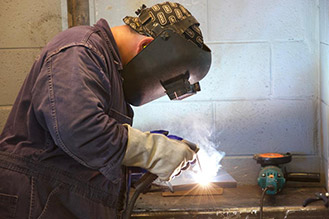In all skilled occupations, employers are becoming greatly concerned about the shortage of candidates with the necessary skills and abilities required, according to the Minnesota Department of Labor and Industry.

Apprenticeships are a powerful workforce development tool, which currently is underutilized, does have significant potential to benefit both the employer and the employee. In 2015, Minnesota was awarded a $5 million grant through the U.S. Department of Labor as part of its American Apprenticeship Initiative to expand registered apprenticeships. Through this grant, Minnesota can engage more than 100 employers in developing registered apprenticeship programs to recruit and train 1,000 new apprentices in 30 occupations.
Apprenticeship programs are designed to produce skilled workers who are fully competent in all aspects of an occupation, including: knowledge, skills and proficiency. Apprenticeships also offer opportunities to students to obtain college credits, veterans and incumbent workers to add skills needed to advance in their jobs, and unemployed workers to seek additional skills and credentials. In fact, apprenticeships pay significantly higher wages than the median hourly wage for south central Minnesota, according to the Minnesota Department of Employment and Economic Development.
“[Apprenticeships] build the workforce of the future, whether they stay here or go to another community, the hope is they will come back,” notes Krista Ahlers, senior manager with MTU Onsite Energy in Mankato. Ahlers works on a manufacturing apprenticeship program specially design for youth, Youth Employment Acceleration Program (YEAP). The YEAP program works with three sites in Mankato: MTU OnSite Energy, EI Microcircuits, and Kato Cable. Ahlers notes that a few graduates of YEAP have stayed at one of the three sites, some have gone to a local technical school, and others who have left still keep in touch. According to Ahlers, programs like YEAP help build resumes and experience in addition to what the students receive in class. While advancing the industry by building the workforce of the future is a primary goal of YEAP, it is also a retention and recruitment tool.
For a job to be an apprenticeship, it requires at least 2,000 hours of hands-on training. Additionally, there must be 144 hours of technical instruction in one year. According to the Department of Labor and Industry, apprenticeships range from 2,000 hours to 10,000 hours, with most falling in the 2,500 to 8,000 range with 180 to 576 hours of related technical instruction. Even with the length to complete the program, apprenticeships offer a win for employers as well as the employee.
To learn more about the role apprenticeships play in the workforce puzzle, Region Nine Development Commission interviewed LeRoy Kiecker, a workforce development representative from the Minnesota Department of Employment and Economic Development.
What is your role in working with apprenticeships programs?
My role is to reach out to manufacturers and build interest in apprenticeships. In doing so, I approach my job from the prospective of building bridges between manufacturers and South Central College. Apprenticeship focuses on new hires as well as current employees. The idea is to use classroom training at South Central College to supplement their regular jobs where they learn the on the job piece through mentorship of a more skilled employee.
What are some underutilized industries or occupations in the apprenticeship programs from your perspective?
My specific role was to focus on advanced manufacturing. I see potential, however, in using apprenticeships in almost any industry/vocation. Our most immediate attention gets focused on the high demand shortages of employees: manufacturing, health care, information technology and agriculture. I would love the opportunity to advance apprenticeship in those areas as well as manufacturing.
What are some barriers and/or challenges to the apprenticeship program that you see?
Perception is a huge barrier. Future employees have a perception of what they believe an employer does and what that job would be like. In most cases, that perception is false. Manufacturing has changed dramatically in the past 10 years and continues to do so with the addition of robotics and electronics into the manufacturing process. What once may have been perceived as a dirty and routine job has evolved into cleaner, brighter environments.
Current employees also have a perception that apprenticeship is for the ‘younger generation’ or new workers. The way I recommend an apprenticeship is to use it as a ladder to gain the knowledge necessary to advance the workforce to either a promotion or higher wages because of the knowledge and experience gained.
In many cases, employers have been dealing with a lack of applicants for a few years because our area unemployment rate is so low. My goal is to get to focus on building an employee pipeline.
In your opinion, what is the value that apprenticeships bring to our region?
I see apprenticeship as an untapped opportunity. Building a bridge from the local high school into future careers with local businesses may help keep our high school graduates from leaving our small towns for metropolitan opportunities. In that sense, keeping more of those young people in our area towns and cities will help the local economy all around. They will buy houses, cars and send their kids to the area schools.
Ultimately, it creates a process where the employee is better educated. The employee will learn the latest techniques and processes from the college as well as the experience of the skilled mentor. The employer in turn will get a more educated and skilled employee. The one catch? It is up to the employer to keep those newly trained apprentice/employees working for their business. Creative methods can build employee loyalty.
Region Nine Development Commission has explored potential tactics to respond to the impending workforce shortage: those who work with immigrant and refugee populations, Adult Basic Education, and apprenticeships. These are only three avenues of resources available to employers to help fill their vacancies. Other tactics and partners exist, such as the South Central Minnesota Career Pathways programs, Minnesota’s workforce centers and staffing agencies, as well as higher education career pathway programs and career services counselors.

